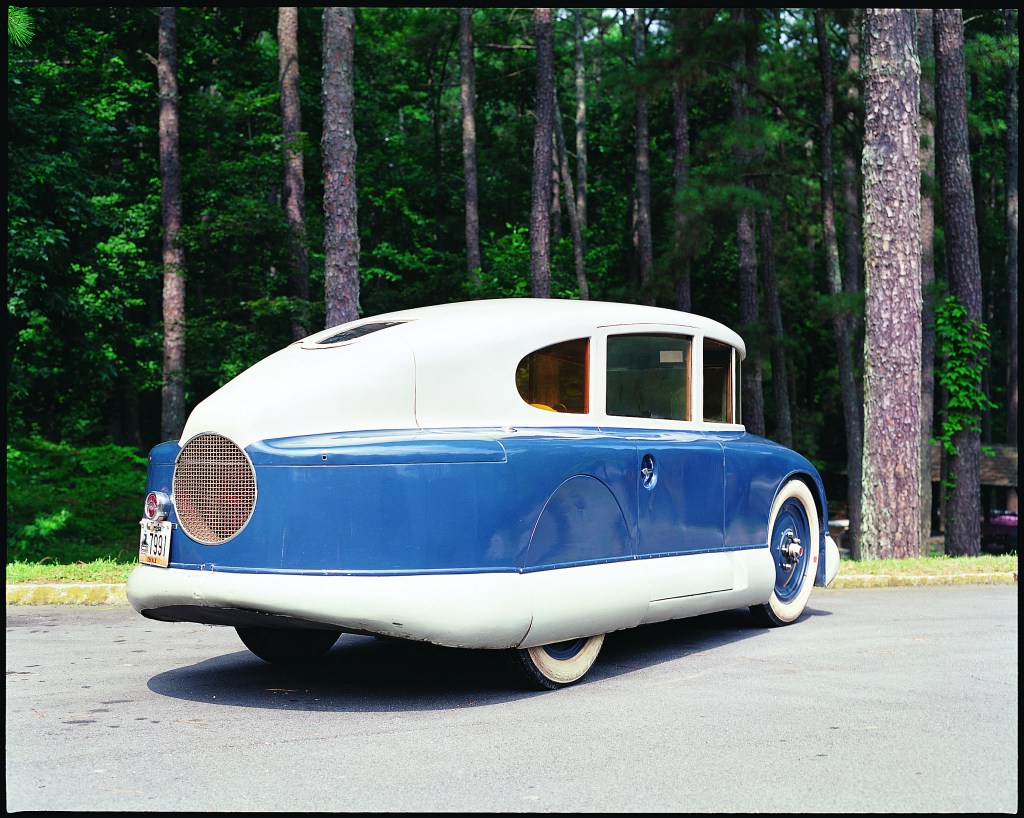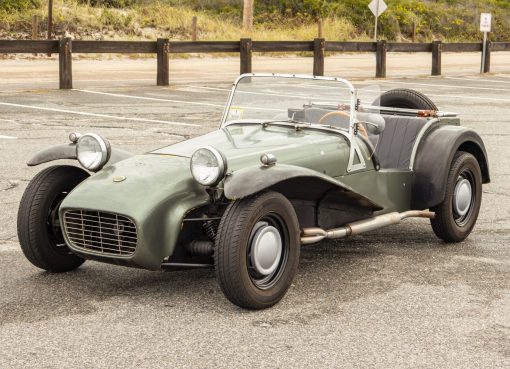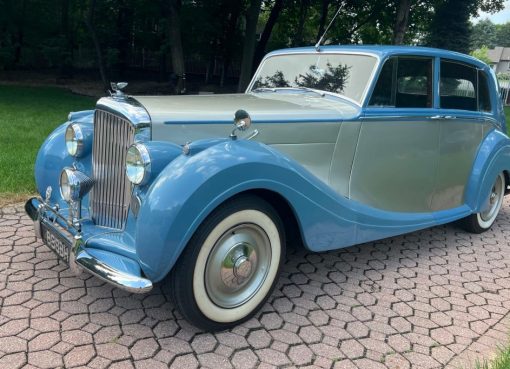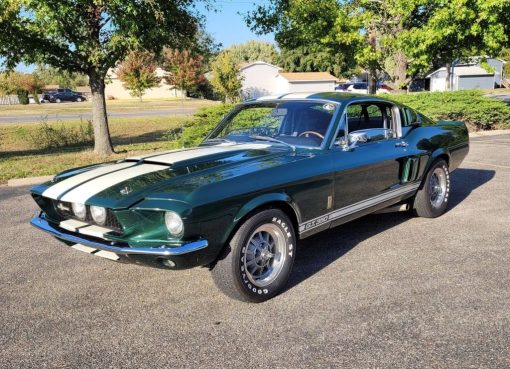Freaks of History: The 1928 Martin

Martin Aircraft Company was well known for their China Clippers, and for their successful World War II bombers, but their entry into automotive production is generally not known at all. Yet, here is a one-off “Aerodynamic Auto” that they built in 1928 for the famous flyer, Billy Mitchell. The exact reasons for its being built have been lost to history, but perhaps Martin and other loyal supporters offered it as consolation after Mitchell’s treatment by the War Department in 1926 (See sidebar below). In any event, the result was this cozy machine, unusual in its appearance; a real traffic stopper and crowd pleaser, in its day. As one might expect, the construction is more aircraft than automobile, with aluminum panels formed over a wood framework; a full belly pan under the vehicle; engine and transmission in the rear, operated by cables and rods; aircraft suspension with elastic straps attached to the shock absorbers; and one door to enter the cabin.

Apparently side protection was as important then as it is today, for the bumpers give new meaning to the word “wrap-around.” Although the front and rear bumpers are sturdy steel, the side bumpers are wood filled, with just a layer of aluminum over them. The car has very little chrome trim, only the door handle, the windshield frame, headlight rings, taillight, and exhaust screen in the rear. Although unusual looking today, it is hard for us to put ourselves back in time to 1928, when this car was new. We have to erase the Aerodynamic Cadillac of 1933, the Chrysler Airflows of the mid-thirties, the Pierce-Arrow Silver Arrow, and the post-war Nash from our memories, to even begin to imagine the impact of seeing such a car on the streets of 1928.

Compare it to the accompanying photo of the stylish 1928 Packard, and begin to realize what an apparition this car would have been in traffic. Unfortunately, it didn’t see much traffic, for it has only 672 miles on the odometer, a testament to its terrible handling characteristics. Each of its four owners, down through the years, tried it out, and then kept it around as a curiosity.

Its current owner, Tommy Protsman, keeps it in his most entertaining “Stone Mountain Antique Car & Treasure Museum,” at Stone Mountain, Georgia. More than just an automobile museum, it is a treasure-trove of toys, jukeboxes, player pianos, Tiffany lamps, clocks, pedal cars, Lionel trains, and more. It is well worth a visit, and you won’t be disappointed. Tommy and his son, Bob, are usually there to greet visitors, and if you get Tommy started talking about the old days, that’s worth the visit, alone. He sang on the stage, in commercials, and in the movies; starting out in 1935 on the same program with Red Skelton at Lakewood Park in Atlanta. His memorabilia from Hollywood is on display, and is fascinating. Tommy’s experience driving the Martin is probably typical of all of the owners. He and his wife decided to take it on a Glidden Tour, a few years back, so he got it running, boiled out the radiator and gas tank, checked the mechanical brakes, and generally put everything in order. After a few miles of jouncing along in the cramped driver’s seat, he was relieved to find that the engine was overheating and they would be forced to turn back. He switched their luggage to a different car to finish the tour, and that was the Martin’s last outing, until he and Bob so kindly rolled it out for our photo session.

The engine overheating may have always been a problem, for the air enters through the grille at the front of the car, goes through the radiator, must then travel through the space between the floor board and the belly pan, past the engine in the rear, and then exit through the small round screen in the rear. When the car is standing still, the only means of keeping the air moving is a single fan mounted in front of the exit screen. The fact that the fan has 24 blades is indicative of the fact that keeping the air moving was a problem, right from the beginning. To further complicate things, the stock water pump must send the water the length of the car through pipes to the front radiator and then back again.

The engine is a four-cylinder, Continental Red Seal, similar to those used by the many assembled cars of the era. The engine accessories are nothing unusual, with Auto-Lite Starter, Generator, and Distributor. The carburetor is a Zenith, looking like the ones used by Ford. The engine faces the rear of the car, with the fan facing out the back, and the rear of the engine is attached to a trans-axle. With so few miles on the car, everything is factory fresh, right down to the pink porcelain Firestone spark plugs. A large metal overflow tank for the radiator is mounted in the engine compartment, and unfortunately has the filler cap in there, too. This means that the rear engine compartment cover has to be removed to check the water or oil, and this is a two-man job. A special tool unlocks the cover, and then it has to be lifted off and set on the ground. Once again, more aircraft than automobile.

The wheelbase is a mere 86 inches; overall length is 158 inches, and the turning circle is 29 feet 10 inches. The original 4.85 x 19 tires, still on the car and fairly well cracked by now, are Martin Cord whitewalls. Martin tires were popular in the twenties and thirties, and not related to the aircraft company.

Steering is fast, with only 1.3 turns, lock to lock, and the horn button is not in the center of the wheel, but to the left of the driver below the window. A dual-purpose switch mounted on the steering column brace is somewhat confusing, with the ignition key in the center, and an arm switch for the headlights that says, “Curb, Off, Bright, and Dim.” The headlights themselves are marked “Saf-De-Lite” with lenses by “Monogram.” The Delco-Remy electric windshield wiper is an innovation in an era when most were still using vacuum. The front windshield opens and the side windows roll down to let the breezes blow through for the comfort of the passengers. The Art-Deco instrument panel is typical of twenties cars, but it’s too bad they passed up the opportunity to use a futuristic dashboard in keeping with the exterior design. The speedometer reads to 100, but it’s hard to imagine that anyone ever tried to go that fast, or that the vehicle, in fact, could do it.

Entry is via the single door on the curb side and on the door sill it says, “Martin,” in script letters. The driver sits in a bucket seat behind the wheel, and even though the passenger side seatback tilts forward, there isn’t room to stand up, so there is no graceful way, except to crawl across it, to get into the driver’s seat. A seat across the back will barely accommodate two, so at best, it is a four-passenger sedan. The upholstery is brown mohair on the seats and side panels, with matching carpets throughout. All in all, the cabin is cozy for four, definitely the compact car of the future.

A deluxe car designwise, perhaps an exciting exercise for a group of aircraft engineers and designers, who normally would not have entered the automotive world. Does it deserve the title “Aerodynamic Auto”? We think so. Does it leave something to be desired in certain mechanical aspects? Of course. But, this was 1928. Who else had molded-in headlights and a waterfall grille? Who else had enclosed rear wheels behind fender skirts, a recessed door handle, rear mounted engine, and a fastback design. Does the front remind you of a Union Pacific Streamliner? That was 1935. Does the rear remind you of a Nash Airflyte? That was 1949. How glad I am that this neat little piece of American ingenuity has survived, and how fortunate we are that Tommy Protsman has it on display in his museum, for all to enjoy.

Billy Mitchell: Gadfly and Hero
It was September 1, 1925, when the 680-foot airship Shenandoah—the first rigid dirigible to be filled with helium rather than the more treacherous hydrogen—left her hangar at Lakehurst, New Jersey, for a routine flight. There was no military purpose to the exercise; it was simply a matter of public relations on the Navy’s part. A crowd of thousands had gathered at the Des Moines, Iowa, fairgrounds, hoping for a glimpse of this great “battleship of the skies.”
The weather was not promising, but the Navy, ignoring warnings from Commander Zachary Lansdowne, the Shenandoah’s skipper, was determined to send the airship out where it could be seen by the public.
Some months earlier the Shenandoah had sustained some storm damage when she was ripped from her mooring mast, tearing her nose section and two gas cells. This time, she was flying with ten of her eighteen safety valves missing, removed by the crew for economy and convenience. Furthermore, one of her engines had been removed. Her designer, Jerome Hunsaker, had protested these alterations, but to no avail.
Commander Lansdowne studied the weather map without comment that evening. Hours later, at 3:00 a.m., he was awakened by one of the mechanics, the first man aboard to see lightning. But mindful of his orders to pursue the planned course, he pushed on. Presently the ship rose out of control to 5,000 feet, 1,200 feet above the safe pressure level. Early daylight observers, watching from earth, saw her “swinging like a pendulum.” At 6,000 feet she entered the eye of a squall.
At 6,300 feet the rise ended abruptly, and the Shenandoah plummeted, falling to 3,200 feet in less than two minutes. Then as Lansdowne ordered the ship to turn south, she began to rise once more, faster than before and once again out of control. At 6,200 feet there was a tremendous vibration, and the Shenandoah began to come apart. Fourteen officers and men, including Commander Lansdowne, lost their lives in the ensuing debacle. The wonder is that the entire crew didn’t perish!
The Shenandoah tragedy came on the heels of another catastrophe, just a day earlier, in which five Navy fliers were lost. Brigadier General William “Billy” Mitchell, assistant chief of air service and the Army’s—and indeed the nation’s—foremost champion of air power, was asked by reporters to comment on the twin disasters.
Forthright as always, Billy Mitchell replied, “My opinion is as follows: These accidents are the result of the incompetency, the criminal negligence, and the almost treasonable administration of our national defense by the Navy and War departments.”
The truth of Mitchell’s statement must have been obvious to any unbiased observer. But in the military, one does not speak thus of one’s superiors. Court-martialed by the Army, Billy Mitchell was found guilty of “making statements to the prejudice of good order and military discipline.” In other words, of insubordination. Sentenced to reduction to the rank of colonel, and five years’ suspension from the service with loss of pay and allowances (though half of them were eventually restored), Mitchell resigned from the Army in 1926 and retired to his Virginia farm.
But Billy Mitchell continued to speak out, as he always had. Thirty years before Pearl Harbor he had predicted that war between the United States and Japan “sooner or later seems quite certain.” And in the years following World War I he warned that “the military spirit of Germany is by no means crushed,” and called for a strong, autonomous air force as America’s first line of defense.
By December 7, 1941, Mitchell’s predictions had come true, but he wasn’t around to savor his vindication, for death had claimed him on February 19, 1936.
There were a couple of postscripts to the story. In 1942, the US Senate passed a bill raising Billy Mitchell, posthumously, to the rank of Major General. The change of rank was never officially made, but in 1946 Congress voted him a special Medal of Honor.
And in 1953 William Mitchell, Jr., youngest of Billy’s five children, asked the Air Force to set aside the court martial verdict. The plea was based on a section of the US Military Code permitting the Secretary of a military Department to “correct any military record…when he considers it necessary to correct an error or injustice.”
Hundreds of newspaper editorials urged that the request be granted, and the Air Force Board of Correction of Military Records (composed entirely of civilians) agreed. But Secretary of the Air Force James H. Douglas, who had the final authority in the matter, responded: “The history of recent years has shown that Colonel Mitchell’s vision concerning the future of air power was amazingly accurate. He saw clearly the shape of things to come in the field of military aviation, and he forecast with precision the role of air power as it developed during World War II, and as we see it today. Our nation is deeply in his debt…. Colonel Mitchell’s views have been vindicated. But while on active duty, and subject to the discipline of the military service, he characterized the administration of the War and Navy Departments as incompetent, criminally negligent and almost treasonable.”
Having thus justified the incredible action that had been taken against Billy Mitchell, Secretary Douglas refused the application to set aside the verdict of the court martial.
But then, whoever said that life is fair?
The post Freaks of History: The 1928 Martin appeared first on The Online Automotive Marketplace.


